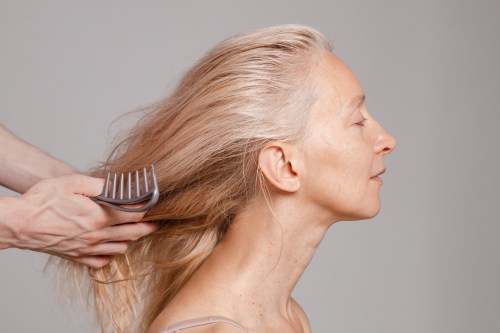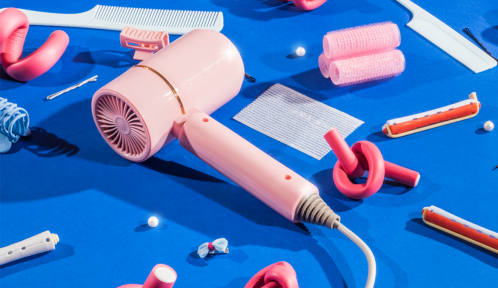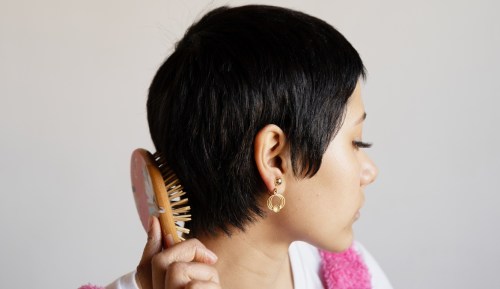Hair textures are different, and that’s a good thing. (The world would be far less interesting if everyone’s hair looked the same, no?) But whether your hair is kinky, wavy, curly, or straight, every one of its strands has a protective outer layer called the cuticle. It comprises dead cells that overlap and fit together in an organized layer—almost like tiles on a roof—and give your hair 360 degrees of protection. If your strands are naturally curly or have been damaged, you likely have high-porosity hair, which means these “tiles” may be less uniform and therefore more vulnerable.
Experts in This Article
hairstylist and the director of education at Flow
senior beauty scientist at Proctor &
Tina Outen is a celebrity stylist at Sessions Salon in London. She has worked with A-listers including Victoria Beckham, Rosamund Pike, Jennifer Lawrence, and Lady Gaga.
“High-porosity hair looks like chunkier misshapen tiles that lie more randomly,” says Tina Outen, a London-based hairstylist. “It’s like a jigsaw puzzle that’s been forced together with gaps and holes exposed, protecting the hair shaft only randomly.” While these gaps make it easier for moisture and oils to get into the strand, they also make it easier for them to escape, which makes your hair more prone to damage and dryness.
Since high-porosity hair requires its own specific type of TLC in order to avoid damage and breakage, we asked stylists to weigh in on everything you need to know about taking care of it. Read on for what they have to say.
How to tell if you have high-porosity hair
“Hair porosity [describes] how well hair strands absorb and retain moisture,” says Jennifer Davis Alexander, PhD, head of research and development for natural hair care brand Sunday II Sunday. She explains that the more the cuticle is raised, the easier hair can absorb—and then lose—moisture. “That makes the hair more prone to excessive dryness, frizz and breakage,” she notes.
Certain textures tend to be naturally more porous than others. “Curly girls are more prone to high porosity because the curvature of the hair causes the cuticle to lift,” says Dr. Alexander. As Rolanda Wilkerson, PhD, principal scientist at P&G Beauty puts it, “That’s because at each twist, turn, and bend of the hair, there are natural places where the cuticles are uplifted, which allows for water to flow in and out of the hair, making the hair porous.”
Genetics aside, certain damage-inducing habits can strip away the protective lipid layer from your strands, which increases the porosity in any hair type. “Heat styling, chemical processing, and UV exposure all cause the cuticles to raise away from the hair shaft, allowing moisture to absorb and evaporate quickly,” says Melanie Bolton, director of education at Flow Hair Care. So even if you may have started out with low- or medium-porosity hair, years of heat styling and chemical treatments can make it more porous.
How to test hair porosity
You can learn a lot about your hair’s porosity based on how it behaves on a daily basis. “If your hair does not get wet easily in the shower, takes forever to dry, and doesn’t take color easily, it’s likely low-porosity,” says Bolton. “If it’s chemically damaged, dry, frizzy, and breaks easily, it’s likely high-porosity,” says Bolton. “If your hair takes color beautifully, is not frizzy, and feels moisturized, you are right in the middle.”
If you’re not totally sure where you fall on the spectrum, simply drop a single strand of hair into a glass of water. If it floats, it’s low-porosity. If it sinks quickly, it’s high-porosity. If it slowly drifts to the bottom, it’s medium-porosity. For the best (and most accurate) results, be sure to test on hair that hasn’t been recently conditioned or treated with styling products.
How to care for high-porosity hair
High-porosity hair needs special care to avoid thinning, brittle texture, and breakage, says Dr. Alexander: “Avoid shampooing too often, chemical treatments such as bleaching or relaxing, leaving sweat on the hair post-workout, overmanipulation of the hair from excessive combing or brushing, using excessive heat when styling, and putting excessive tension on the hair from certain hairstyles such as tight ponytails.”
Though you can’t technically change your hair’s porosity (it is, after all, largely genetic) using certain hair-care products can help keep it healthy. Limiting your washes will allow your hair’s natural oils to prevent dryness, for instance—which is so important. “The goal for high-porosity hair types is to seal the cuticle and deeply moisturize the hair,” says Bolton. “Everyday care should be based around reparative products that contain proteins and humectants for strength and moisture retention.” When choosing products, look for ingredients such as coconut oil, argan oil, and green tea, which will add moisture to your hair while also sealing the cuticle and protecting against environmental stressors.
Use a deep-conditioning treatment once a week, and finish off every lather cycle with a cold-water rinse, which will help seal the cuticle to prevent moisture loss throughout the day. According to Bolton, protein-rich treatments can also help to “fill the gaps” on your strands by coating the cuticle, which will help your hair retain moisture. And if you’re dealing with breakage from chemical services, Outen recommends integrating a bond multiplier, like Olaplex, into your routine to repair some of the damage.
How to style high-porosity hair
When styling high-porosity hair, protection should be top of mind. “It’s important to take care of the hair during styling to avoid damage and breakage,” says Dr. Wilkerson. This means limiting chemical processes, keeping hot tool use at a minimum (or at least, a low temperature), and always using a heat protectant.
“For high-porosity hair, less is more,” says Outen. “The quicker you can style your hair, the less you’re stressing it out, so perhaps try for a look that’s close to your natural texture and easily achieved.” Protective styles like braids are a great option, as is embracing your natural curls. “Look for products and styles that appear to give your hair the most protective barrier—in other words, what makes your hair feel its nicest for the longest,” says Outen. “Our personal expectation of our hair plays a role here, so experiment until you find your ‘hair happy place.'”And if you’re looking to try a new cut, and need a little inspiration, check out the video below:
Want even more beauty intel from our editors? Join Well+Good’s Fine Print Facebook group (and follow us on Instagram) for must-know tips and tricks.
Sign Up for Our Daily Newsletter
Get all the latest in wellness, trends, food, fitness, beauty, and more delivered right to your inbox.
Got it, you've been added to our email list.










